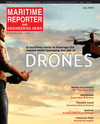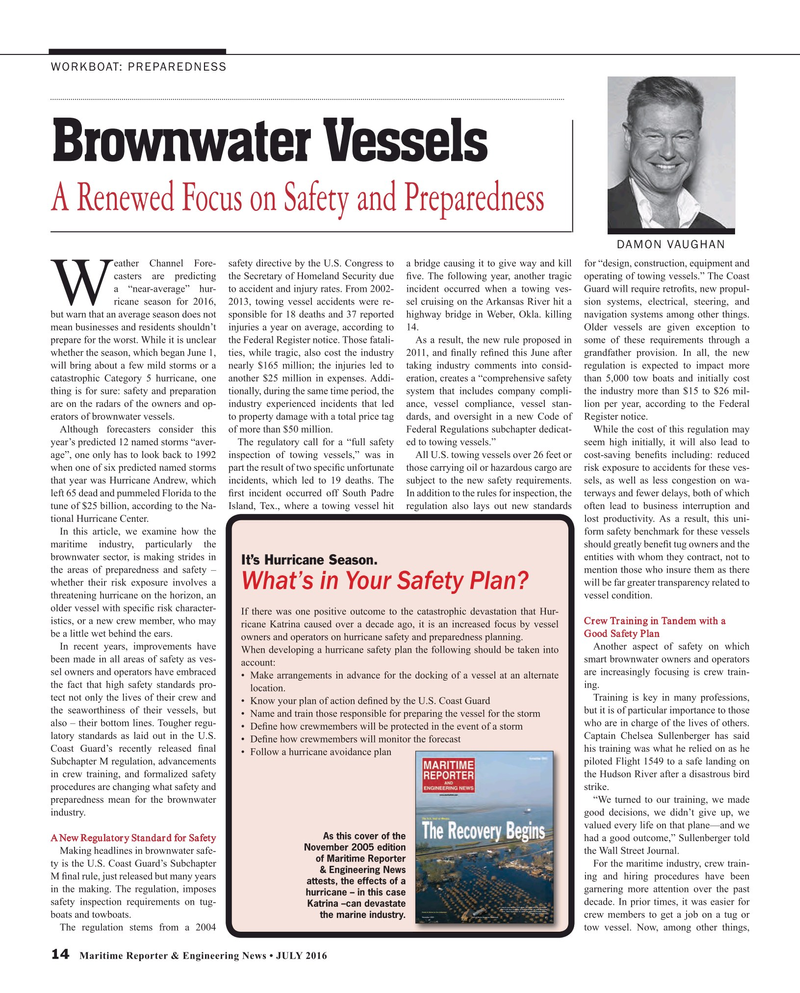
Page 14: of Maritime Reporter Magazine (July 2016)
Marine Communications Edition
Read this page in Pdf, Flash or Html5 edition of July 2016 Maritime Reporter Magazine
WORKBOAT: PREPAREDNESS
Brownwater Vessels
A Renewed Focus on Safety and Preparedness
DAMON VAUGHAN eather Channel Fore- safety directive by the U.S. Congress to a bridge causing it to give way and kill for “design, construction, equipment and casters are predicting the Secretary of Homeland Security due ? ve. The following year, another tragic operating of towing vessels.” The Coast a “near-average” hur- to accident and injury rates. From 2002- incident occurred when a towing ves- Guard will require retro? ts, new propul- ricane season for 2016, 2013, towing vessel accidents were re- sel cruising on the Arkansas River hit a sion systems, electrical, steering, and
W but warn that an average season does not sponsible for 18 deaths and 37 reported highway bridge in Weber, Okla. killing navigation systems among other things. mean businesses and residents shouldn’t injuries a year on average, according to 14. Older vessels are given exception to prepare for the worst. While it is unclear the Federal Register notice. Those fatali- As a result, the new rule proposed in some of these requirements through a whether the season, which began June 1, ties, while tragic, also cost the industry 2011, and ? nally re? ned this June after grandfather provision. In all, the new will bring about a few mild storms or a nearly $165 million; the injuries led to taking industry comments into consid- regulation is expected to impact more catastrophic Category 5 hurricane, one another $25 million in expenses. Addi- eration, creates a “comprehensive safety than 5,000 tow boats and initially cost thing is for sure: safety and preparation tionally, during the same time period, the system that includes company compli- the industry more than $15 to $26 mil- are on the radars of the owners and op- industry experienced incidents that led ance, vessel compliance, vessel stan- lion per year, according to the Federal erators of brownwater vessels. to property damage with a total price tag dards, and oversight in a new Code of Register notice.
Although forecasters consider this of more than $50 million. Federal Regulations subchapter dedicat- While the cost of this regulation may year’s predicted 12 named storms “aver- The regulatory call for a “full safety ed to towing vessels.” seem high initially, it will also lead to age”, one only has to look back to 1992 inspection of towing vessels,” was in All U.S. towing vessels over 26 feet or cost-saving bene? ts including: reduced when one of six predicted named storms part the result of two speci? c unfortunate those carrying oil or hazardous cargo are risk exposure to accidents for these ves- that year was Hurricane Andrew, which incidents, which led to 19 deaths. The subject to the new safety requirements. sels, as well as less congestion on wa- left 65 dead and pummeled Florida to the ? rst incident occurred off South Padre In addition to the rules for inspection, the terways and fewer delays, both of which tune of $25 billion, according to the Na- Island, Tex., where a towing vessel hit regulation also lays out new standards often lead to business interruption and tional Hurricane Center. lost productivity. As a result, this uni-
In this article, we examine how the form safety benchmark for these vessels maritime industry, particularly the should greatly bene? t tug owners and the brownwater sector, is making strides in entities with whom they contract, not to
It’s Hurricane Season. the areas of preparedness and safety – mention those who insure them as there whether their risk exposure involves a will be far greater transparency related to
What’s in Your Safety Plan?
threatening hurricane on the horizon, an vessel condition.
older vessel with speci? c risk character-
If there was one positive outcome to the catastrophic devastation that Hur- istics, or a new crew member, who may Crew Training in Tandem with a ricane Katrina caused over a decade ago, it is an increased focus by vessel be a little wet behind the ears. Good Safety Plan owners and operators on hurricane safety and preparedness planning.
In recent years, improvements have Another aspect of safety on which
When developing a hurricane safety plan the following should be taken into been made in all areas of safety as ves- smart brownwater owners and operators account: sel owners and operators have embraced are increasingly focusing is crew train- • Make arrangements in advance for the docking of a vessel at an alternate the fact that high safety standards pro- ing. location. tect not only the lives of their crew and Training is key in many professions, • Know your plan of action de? ned by the U.S. Coast Guard the seaworthiness of their vessels, but but it is of particular importance to those • Name and train those responsible for preparing the vessel for the storm also – their bottom lines. Tougher regu- who are in charge of the lives of others. • De? ne how crewmembers will be protected in the event of a storm latory standards as laid out in the U.S. Captain Chelsea Sullenberger has said • De? ne how crewmembers will monitor the forecast
Coast Guard’s recently released ? nal his training was what he relied on as he • Follow a hurricane avoidance plan
Subchapter M regulation, advancements piloted Flight 1549 to a safe landing on in crew training, and formalized safety the Hudson River after a disastrous bird procedures are changing what safety and strike. preparedness mean for the brownwater “We turned to our training, we made industry. good decisions, we didn’t give up, we valued every life on that plane—and we
As this cover of the
A New Regulatory Standard for Safety had a good outcome,” Sullenberger told
November 2005 edition
Making headlines in brownwater safe- the Wall Street Journal. of Maritime Reporter ty is the U.S. Coast Guard’s Subchapter For the maritime industry, crew train- & Engineering News
M ? nal rule, just released but many years ing and hiring procedures have been attests, the effects of a in the making. The regulation, imposes garnering more attention over the past hurricane – in this case safety inspection requirements on tug- decade. In prior times, it was easier for
Katrina –can devastate boats and towboats. crew members to get a job on a tug or the marine industry.
The regulation stems from a 2004 tow vessel. Now, among other things, 14 Maritime Reporter & Engineering News • JULY 2016
MR #7 (10-17).indd 14 7/6/2016 9:53:34 AM

 13
13

 15
15
